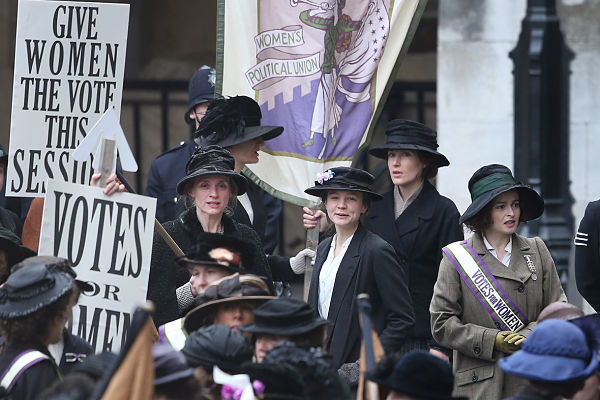 International Debate
International Debate Suffragette – More than a Feminist Movie

Ann-Marie Duff, Carey Mulligan and Helena Bonham Carter in a scene from the new movie Suffragette. (Photo courtesy Pathe)
Suffragette is a brave movie within the constraints of the genre and its certificate. The violence of the movement, and of the state’s response, are depicted to the limits of acceptability to a family audience – which means a fair degree of sanitization, especially in the force-feeding scene. In reality, this was not the aggressive passage of a naso-gastric tube, shown here. Various metal instruments clamped the women’s jaws, often causing permanent damage. Rubber tubes were fed through these, sometimes into the lungs rather than the stomach. Even assuming a willing actor, and affordable dental insurance, the brutality would raise the certificate level to exclude younger teenagers. Similarly, the sexual harassment of a 13-year-old girl by a male laundry supervisor is skated round to the point of near obscurity. The female actors look too well kept for women of the period and the laundry appears to have acquired halogen lighting before its time.
Nevertheless, this is not a Hollywood turkey to compare with How Green Was My Valley. Even the cameo from Meryl Streep as the suffragette leader Emmeline Pankhurst works in capturing the charisma noted by so many contemporaries. Our heroines are credibly swept away by their leader’s sheer presence– with more than a hint of the fascist tones that her later career took on.
The film’s moral center, though, is the relationship between Carey Mulligan, as Maud Watts, an ordinary woman radicalized by her everyday experience of oppression, and Brendan Gleeson, as a police inspector transferred from working against Irish Republicans to lead the response to the suffragettes’ increasingly violent actions. Gleeson’s role immediately makes the movie’s wider connections. This assignment employs his past experience in the repression of a new challenge to the British state. It underlines both the historical and the geographical continuity of counter-terror. None of this is unique to the UK. It is the same continuity that links the Tsar’s secret police to those of Josef Stalin or Guantanamo Bay to Homan Square in the US. To the extent that we regard behavior as legitimate towards any group of ‘others’, we justify bringing it back home. Prisoner abuse is not made acceptable because it happens at a distance. Gleeson’s character, however, understands the risks. He presses the civil servants and politicians behind him to consider whether the status quo really warrants a spiral of violence that will lead to deaths on one side or the other. What is the social and political price of resisting reform?
As Maud Watts notes in a letter to the inspector, when she refuses to become a police informer, they are both foot soldiers in their respective causes. Just as Gleeson is concerned about where to draw a line on behalf of the state, Mulligan’s character is constantly required to navigate the boundaries of political violence. When is this justifiable in pursuing grievances dismissed by an arrogant and indifferent political elite? Male liberals offer warm words but no action against the injustices of class and gender experienced by the women protagonists. A decisive moment occurs when Lloyd-George, the Chancellor of the Exchequer, who has earlier shown sympathy with the suffragist cause, tells a crowd of women that there has been a discussion, and a vote. They have lost and it is now time to go home. As he leaves to shouts of betrayal, the police forcibly break up the crowd. The appearance of mounted officers takes us both back to the 1819 Peterloo Massacre and forward to the 1990 Poll Tax riots. Who has triggered the spiral of violence?
Maud Watts is among those who are randomly beaten, arrested and imprisoned. The experience provokes her full commitment to the movement’s radical actions. As Helena Bonham Carter’s pharmacist makes bombs, Mulligan helps to plant them. It is the moral equivalent of the Black Panthers’ assertion that the constitutional right to bear arms also includes black people. Violence is a legitimate response to a state that itself uses violence to suppress the expression of grievances.
The film’s moral ambiguity on the issue of violence is distinctive. Both Mulligan and Gleeson are reluctant users of violence, compared with others of their party. At the same time, both are convinced of its justifiability in some circumstances as a legitimate tactic, whether by the state or by its opponents. This contrasts with the simple narratives that have marked many media representations since 9/11. State violence is acceptable, particularly when carried out by romantic heroes. Popular violence is bad, carried out by people with dark skins and other undesirable attributes.
Suffragette invites us to think about the consequences of political systems that are supposedly democratic but systematically exclude many voices. Is 35 percent of a popular vote on a 60 percent turnout really a mandate to impose a manifesto, backed by the state’s claimed monopoly on legitimate violence? Is there more to government than this? Can the state’s use of violence ever justify the use of violence against it by those shut out from other channels of redress? The film refuses to provide a definitive answer – but it does treat the question as worth asking.
Take your daughters to this movie by all means – but don’t leave your sons behind.































































































The film’s moral ambiguity on the issue of violence is distinctive. Both Mulligan and Gleeson are reluctant users of violence, compared with others of their part